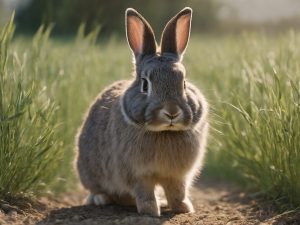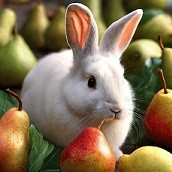Do Rabbits Eat Kentucky Bluegrass? Diet & Preparation Tips
Kentucky Bluegrass Unveiled
Recognized by its scientific name, Poa pratensis, Kentucky Bluegrass boasts more than just aesthetic appeal. The

Is Kentucky Bluegrass on the Menu for Rabbits?
Yes, indeed! Rabbits can safely munch on Kentucky Bluegrass. This grass is a natural treasure trove of fibers, which are essential for a rabbit’s digestive processes. Moreover, the continuous growth of a rabbit’s teeth necessitates consistent wear-down, and what better way to achieve that than by chewing on some good old bluegrass?
The Ideal Quantity
While Kentucky Bluegrass can indeed be incorporated into a rabbit’s meals, it shouldn’t overshadow other dietary essentials. Fresh grass is a treat and should be complemented with a generous serving of
The Bounty of Benefits
- Fiber Galore: A rabbit’s gut thrives on fiber. Kentucky Bluegrass ensures that your rabbit’s digestive machinery runs without a hitch and simultaneously cares for its dental health.
- Calories in Check: Being naturally lean on calories, Kentucky Bluegrass is a guilt-free snack that poses no threat of obesity.
- Natural Goodness: If you’re plucking it fresh from a reliable source, you’re offering your rabbit a treat devoid of unnatural additives.
Safety First
Before you serve a plateful of Kentucky Bluegrass to your rabbit, ensure it’s pristine. Any exposure to pesticides, herbicides, or other chemicals can spell disaster. It’s imperative to harvest the grass from an environment that’s untouched by harmful chemicals.
Getting the Grass Ready
Offering Kentucky Bluegrass to your rabbit isn’t a herculean task. Here’s a simple guide:
- Aim for the younger, supple blades.
- Give the grass a thorough rinse to wash off external agents.
- Once washed, air-dry the grass to retain its freshness.
- Fresh is best! However, never forget that hay, which is essentially dried grass, remains the mainstay in a rabbit’s diet, thanks to its abundant fiber.
Exploring Alternatives
No Kentucky Bluegrass around? No problem. There’s a plethora of other delightful grasses and foods to keep your rabbit content:
- Timothy Hay: A popular choice, rich in nutrients, perfect for mature rabbits.
- Fruits: An occasional fruit treat is always welcome. Think
(seedless, of course), delectable , , and slices of banana. - Grass Alternatives: From
to Orchard grass and Ryegrass, the list of alternatives is expansive.
To wrap it up, introducing Kentucky Bluegrass into your rabbit’s diet is a commendable move. A blend of taste, health benefits, and natural goodness, this grass is a worthy contender for a spot in your rabbit’s menu. Just ensure it’s sourced from a clean environment, and remember the importance of a balanced diet, which always includes a generous serving of hay.
Summary Can rabbits eat Bluegrass (Kentucky Bluegrass) and its nutrition
| Feature | Description | Reference |
|---|---|---|
| Can rabbits eat Bluegrass? | Yes, rabbits can eat Bluegrass (Kentucky Bluegrass) [1][2][5]. | 1, 2, 5 |
| Nutritional information | Fresh aerial parts of Kentucky Bluegrass contain the following nutritional information during various growth stages: % Protein % Ash % Crude Fiber % N-free Extract growth stage (N x 6.25) immature 17.5 9.4 25.4 44.2 early bloom 16.6 7.1 27.4 44.9 mid-bloom 13.2 7.6 29.2 46.1 milk stage 11.6 7.3 30.3 47.2 dough stage 9.5 6.6 34.8 46.0 mature 9.5 6.2 32.2 49.0 overripe 3.3 6.3 42.1 47.0[1] [5] |
1, 5 |
| Hay for rabbits | Grass hays are best for rabbits, and common sources of hay include Bluegrass, brome, fescue, marsh, orchard, timothy, oat, and ryegrass[5]. | 5 |
| Feeding cycles | Bluegrass does not grow fast enough to outcompete rabbits eating it[3]. | 3 |
| Production | Kentucky Bluegrass seed is grown in the United States[4]. | 4 |
References:
- [1] National Academy of Sciences. (n.d.). Nutritional information for fresh, aerial parts of Kentucky bluegrass.
- [2] Narkive. (2023, September 30). Bluegrass lawns are good for rabbits.
- [3] The Lawn Forum. (2023, September 30). New Scotts ProVista Kentucky Bluegrass.
- [4] Oregon State University Extension Service. (2012, October 1). Grass Seed Straw as a Forage Source for Beef Cattle.
- [5] Wikipedia. (2023, September 26). Domestic rabbit.







Leave a Reply